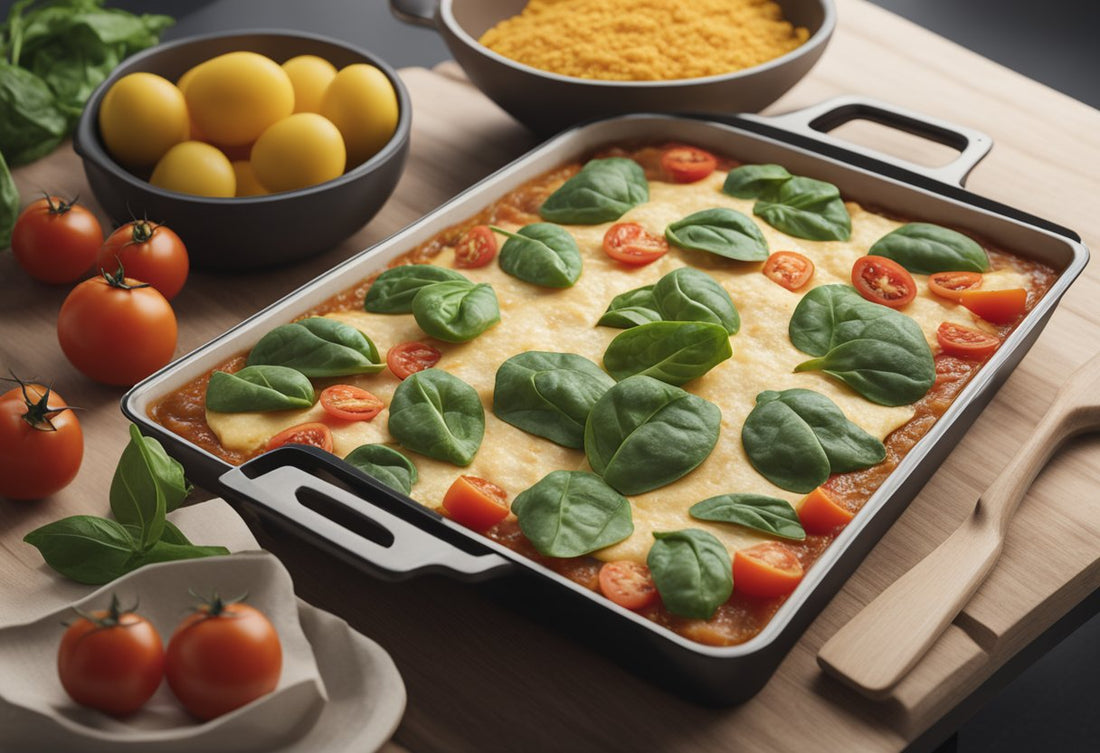
Vegan Lasagne
Share
Are you looking for a delicious and hearty meal that is both vegan and comforting? Look no further than a vegan lasagne recipe! This classic Italian dish can be made without any animal products, making it a perfect choice for those following a plant-based diet.

There are many variations of vegan lasagne recipes available, from lentil and vegetable-filled options to those featuring vegan cheese and creamy sauces. Whether you are a seasoned vegan cook or just starting out, there is sure to be a recipe that will suit your tastes and preferences. With a little bit of preparation, you can enjoy a satisfying and flavourful meal that is both healthy and cruelty-free.
Ingredients

To make a delicious vegan lasagne, you will need a variety of ingredients. Here are the key ingredients you will need to make a mouth-watering vegan lasagne:
-
Pasta: Lasagne noodles are the foundation of this recipe. You can use traditional wheat-based lasagne noodles or gluten-free noodles if you prefer.
-
Sauce: A rich and flavourful sauce is essential for a delicious lasagne. You can use tomato sauce, marinara sauce, or a combination of both.
-
Olive oil: A good quality olive oil is needed to sauté the vegetables and add flavour to the sauce.
-
Garlic: Garlic adds a delicious depth of flavour to the sauce. Use fresh garlic for the best results.
-
Salt and pepper: These two seasonings are essential for bringing out the flavours of the other ingredients.
-
Onion: Onion is used to add sweetness and flavour to the sauce.
-
Mushrooms: Mushrooms are a great meat substitute and add a meaty texture to the lasagne.
-
Sugar: A small amount of sugar is used to balance the acidity of the tomatoes in the sauce.
-
Cheese: Vegan cheese is used to add a creamy and cheesy flavour to the lasagne. Nutritional yeast flakes can also be used to add a cheesy flavour.
-
Lasagne: Of course, you will need lasagne noodles to layer your lasagne.
-
Tomatoes: Fresh or canned tomatoes are used to make the sauce.
-
Flour: Flour is used to make the white sauce that is layered in the lasagne.
-
Milk: Non-dairy milk such as soy, almond or oat milk is used to make the white sauce.
-
Yeast: Nutritional yeast is used to add a cheesy flavour to the white sauce.
-
Basil: Fresh basil is used to add a fragrant and flavourful element to the lasagne.
-
Lentils: Lentils are a great source of protein and can be used as a meat substitute in the sauce.
-
Spinach: Spinach is a great way to add some greens to your lasagne.
-
Vegetables: You can add a variety of vegetables such as courgette, carrots, and celery to the sauce to add more flavour and nutrition.
-
Red wine: Red wine can be added to the sauce to add depth of flavour.
-
Bay leaf: Bay leaves are added to the sauce to add a fragrant element.
-
Tomato purée: Tomato purée is used to thicken the sauce and add flavour.
-
Green lentils: Green lentils are used to add protein to the sauce.
-
Chopped tomatoes: Chopped tomatoes are used to make the sauce.
-
Almond milk/oat milk: Non-dairy milk such as almond or oat milk can be used to make the white sauce.
-
Fresh basil: Fresh basil is used to add a fragrant and flavourful element to the lasagne.
-
Soy milk: Soy milk can be used to make the white sauce.
-
All-purpose flour: All-purpose flour is used to make the white sauce.
-
Onion powder: Onion powder is used to add flavour to the white sauce.
-
Garlic powder: Garlic powder is used to add flavour to the white sauce.
By using these ingredients, you can make a delicious and satisfying vegan lasagne that is sure to impress.
Preparation Method

Making the Sauce
To make the sauce for your vegan lasagne, start by preheating your oven to the required temperature. Then, you will need to make the tomato sauce. In a food processor, blend two cans of whole plum tomatoes until smooth. Next, heat some olive oil in a pan and add finely chopped onion, carrots, celery, and garlic. Cook until softened, then add the tomato paste and cook for a few minutes. Pour in the blended tomatoes and add some vegan red wine, if desired. Season with salt, pepper, and a pinch of sugar. Let it simmer for about 20 minutes or until it thickens.
Preparing the Lasagne
While the sauce is simmering, you can start preparing the filling and lasagne sheets. You can use store-bought vegan lasagne sheets or make your own. If you are making your own, roll out the pasta dough and cut it into rectangular sheets. Boil the sheets in salted water for a few minutes, then drain and set aside.
For the filling, you can use a combination of chopped mushrooms, diced aubergine, courgette, and red pepper. Sauté them in a pan with some olive oil until softened. Add some tomato sauce and let it cook for a few minutes. You can also add some vegan cheese or cashew cream for extra creaminess.
Baking the Lasagne
To assemble the lasagne, spread a layer of tomato sauce on the bottom of a lasagne dish. Add a layer of lasagne sheets, followed by a layer of the filling. Repeat until you have used up all the ingredients, ending with a layer of tomato sauce. Sprinkle some vegan cheese on top, if desired.
Bake the lasagne in the preheated oven for about 30-40 minutes or until it is bubbling and golden brown on top. Let it cool for a few minutes before serving. You can garnish with some fresh basil leaves or parsley and serve with a side salad. Enjoy your delicious vegan lasagne!
Nutrition Informtion
If you're looking for a vegan lasagne recipe that is not only delicious but also nutritious, you've come to the right place. Here's a breakdown of the nutritional information for a typical serving of vegan lasagne:
-
Calories: Depending on the recipe, a serving of vegan lasagne can contain anywhere from 500 to 700 calories.
-
Fat: The fat content of vegan lasagne can vary depending on the ingredients used. Some recipes call for vegan cheese or meat substitutes, which can increase the fat content. On average, a serving of vegan lasagne contains around 16 grams of fat.
-
Protein: Vegan lasagne can be a great source of protein, especially if it contains ingredients like lentils, tofu, or tempeh. On average, a serving of vegan lasagne contains around 27.5 grams of protein.
-
Carbohydrates: Vegan lasagne typically contains a lot of carbohydrates, mainly from the pasta and vegetables. A serving can contain anywhere from 50 to 80 grams of carbohydrates.
-
Saturated Fat: Depending on the recipe, a serving of vegan lasagne can contain around 7 grams of saturated fat.
-
Sugars: Vegan lasagne typically contains very little sugar, especially if it doesn't contain any added sweeteners.
-
Fibre: Vegan lasagne can be a great source of fibre, especially if it contains lots of vegetables. On average, a serving of vegan lasagne contains around 12 grams of fibre.
Overall, vegan lasagne can be a healthy and nutritious meal option, especially if it contains lots of vegetables and plant-based protein sources. If you're watching your calorie or fat intake, be sure to choose a recipe that is lower in these nutrients.
Additional Tips
Making vegan lasagne is a simple and delicious way to enjoy a comforting meal that is both dairy-free and meat-free. Here are some additional tips to help you perfect your vegan lasagne recipe:
1. Prep Time
To save time, you can prepare your vegan bolognese or marinara sauce in advance and store it in the freezer for up to 3 months. This will cut down on your prep time when you're ready to make your lasagne.
2. Vegan Cheese
If you're looking for a dairy-free alternative to cheese, try using vegan parmesan or vegan ricotta. These can be found at most health food stores or online. You can also make your own vegan cheese using cashews, nutritional yeast, and dijon mustard.
3. Vegetables
Don't be afraid to add extra vegetables to your lasagne. Zucchini and eggplant are great additions that will give your lasagne a boost of flavour and nutrition.
4. Nutmeg
Adding a pinch of nutmeg to your white sauce will give it a warm and comforting flavour that complements the other ingredients in your lasagne.
5. Quick and Easy
If you're short on time, you can make a quick and easy vegan lasagne by using store-bought marinara sauce and vegan bolognese. This will cut down on your cook time and still give you a delicious and satisfying meal.
6. Storing and Freezing
If you have leftovers, store them in an airtight container in the fridge for up to 3 days. You can also freeze your lasagne for up to 3 months. To reheat, simply place it in the oven at 180°C for 20-25 minutes.
7. Serve with a Green Salad
To balance out the richness of your lasagne, serve it with a simple green salad dressed with olive oil and balsamic vinegar. This will add some freshness and crunch to your meal.
By following these tips, you can create a delicious and satisfying vegan lasagne that is both gluten-free and dairy-free. Enjoy!
